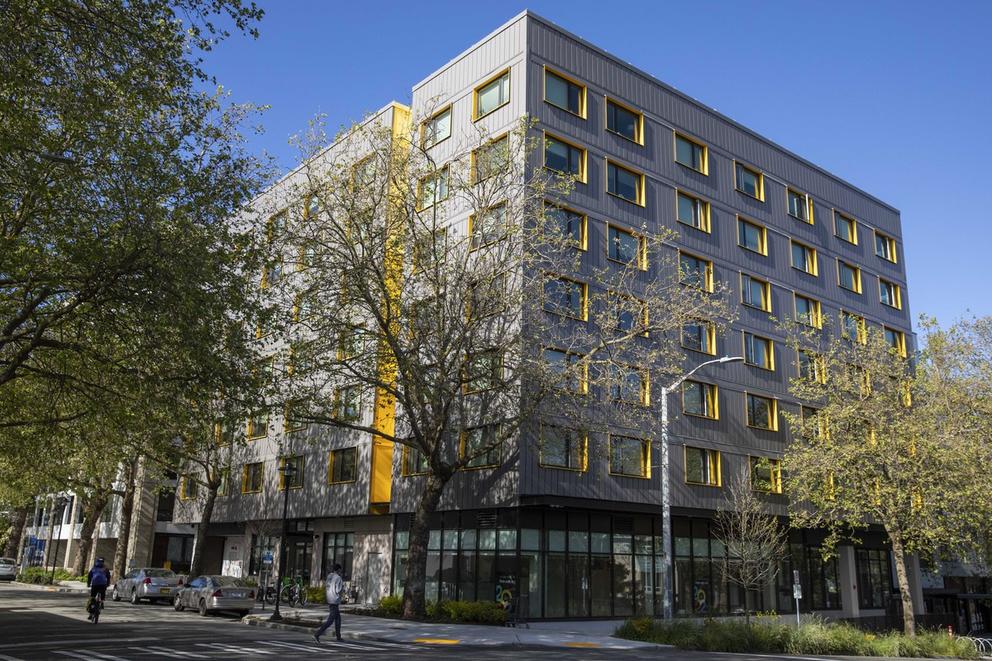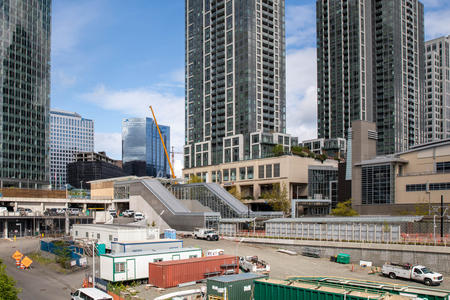A campaign called House Our Neighbors wants to address the growing crisis with something called “social housing.” It’s a housing model funded, built and operated by the government and is used in Singapore, Vienna and other cities around the world. It is just starting to gain a toehold in the United States.
The House Our Neighbors campaign is currently gathering signatures to get Initiative 135 on the ballot this year to ask Seattle voters to create a new public agency called the Seattle Social Housing Developer, which would acquire, build and manage permanently affordable housing for low- and middle-income residents.
“Seattle doesn’t have a plan to get out of the affordability crisis,” said Tiffani McCoy, co-chair of House Our Neighbors. “Every year that goes by where we’re not addressing the deep affordability crisis at scale is another year where more folks enter homelessness and low-income, Black and brown communities are priced out of the city.”
House Our Neighbors argues that social housing would be an addition to Seattle’s affordable housing landscape, not a replacement of any developer providing below-market rentals.
Right now, the vast majority of subsidized affordable housing in Seattle and across the U.S. is built by nonprofit developers. Seattle also still has more than 8,000 units of traditional government-run public housing and a small pool of subsidized units built by market-rate developers in exchange for tax breaks.
“All of these agencies need to keep doing what they’re doing,” said McCoy. “They have the skills to utilize federal financing models. But we need to be honest with ourselves that federal financing is never going to meet the scale of our need.”
So what exactly is social housing, how is it different from our current affordable housing system and, importantly, who’s going to pay for it?
What is social housing?
At its simplest level, social housing is government-built and managed apartments that are permanently affordable to people making a mix of incomes. As House Our Neighbors envisions it, Seattle’s social housing would be available to people with zero income at one end of the spectrum up to those making comfortable middle-class salaries or 120% of the area median income (currently about $116,000 for a family of two).
Making each property available to people earning a mix of incomes serves several purposes. For one, it provides homes to middle-class residents, like Seattle teachers and nurses, who are increasingly squeezed by rising rents. It also provides homes for low-income residents, like service workers, warehouse employees and gig workers. Two, it helps limit the class segregation that occurs when some buildings are for just low-income residents, and some, like new market rate apartments, are just for high-income residents. And three, because rents would be proportional to income, higher-income residents help subsidize rents paid by lower-income residents and generate some cash flow that can pay for necessary building maintenance and repairs, as well as help fund future developments.
This kind of housing already exists in some parts of the world.
In Vienna, Austria, 60% of residents live in mixed-income homes either owned or subsidized by the government. Because so much of the city’s housing stock is subsidized and has lower-than-market-rate rents, social housing has ensured private market apartments don’t charge significantly higher rents. In Singapore, 80% of residents live in government-subsidized social housing.
The social housing concept is starting to gain a little traction in the U.S. as well. Montgomery County, Maryland’s Housing Opportunities Commission is one of the very few, if not only, public housing agencies in the country building new affordable housing without federal subsidy. Its first project, currently under construction, is a 268-unit apartment building with about a third of the units set aside for low-income residents. The California State Assembly passed a bill that would create a statewide social housing development agency. It’s now going in front of the state Senate. The Hawaii State Legislature is also considering a bill, one that would fund mixed-income affordable housing.
The House Our Neighbors campaign has gained some prominent supporters in Seattle, including State Reps. Frank Chopp and Nicole Macri, State Sens. Rebecca Saldaña and Joe Nguyen, King County Councilmember Girmay Zahilay, the King County Labor Council, 350 Seattle, Tenants Union of Washington, Tech4Housing, Seattle King County NAACP and many others.
Building social housing
If Seattle voters approve the ballot measure, city leaders would create a new government agency with the authority to issue tax-exempt bonds.
To build a new social housing development, the agency would start by getting a government grant to seed each project. From there, the developer would sell bonds to investors based on the estimated value of future rents to pay for land acquisition and construction. Once construction is complete and tenants move in, any profit generated by rent after maintenance expenses and loans are paid would be put toward future social housing projects.
The Seattle Social Housing Developer could also purchase existing, market-rate apartment buildings to convert to permanently affordable housing. The campaign expects it would likely start with buying buildings rather than constructing new ones in order to begin generating rents against which to sell bonds.
In a perfect world, the bonds would pay for a project’s entire construction cost, but McCoy of the House Our Neighbors campaign said the social housing developer would use any funding mechanism at its disposal, including taking on loans from a bank, as done by traditional affordable housing developers and for-profit developers.
Maryland’s Housing Opportunities Commission still relies heavily on traditional housing finance, including tax credits and bank loans, in addition to issuing bonds in order to fund its mixed-income projects.
How is this different?
The majority of Seattle’s subsidized housing is built and managed by nonprofit housing developers such as Plymouth Housing, Bellwether Housing, Community Roots Housing and many others. Nearly all of those projects rely on grants from the Seattle Office of Housing's rental housing investment program along with a complicated stew of state grants, tax credits and traditional loans from banks. The city's investment program is funded by fees private developers pay through the Mandatory Housing Affordability program, the voter approved Seattle Housing Levy and a few other sources.
As of December 2021, Seattle has more than 15,600 affordable rental housing units in operation across 328 buildings, with 5,400 planned units in the pipeline, nearly all of which were built or will be built with investments from the Office of Housing.
There are 5,700 rent-restricted apartments in market-rate buildings throughout the city built by private developers in exchange for a tax break through Seattle’s Multi-Family Tax Exemption program. Unlike nonprofit or public housing that remains off the private market for its lifetime (with a few exceptions), affordable units built through the Multi-Family Tax Exemption program have rents that remain below the market for only 12 years. After that period, developers can charge full market rents.
In addition, Seattle’s Mandatory Housing Affordability program has led to private developers building 28 income-restricted units. Private developers’ who don’t include affordable housing in their project pay fees into the city housing fund that seeds nonprofit developments. The Seattle Housing Authority is the city’s traditional public housing agency. It operates 8,390 units of public housing and provides vouchers to help subsidize people’s rents on the private market.
Beyond how developers pay for construction and operation, the key difference between the existing affordable housing model and social housing is who can live in it. Housing built with money from the Office of Housing can serve a range of incomes, but Seattle’s nonprofit developers typically build apartments for those with incomes 0% to 30% of the area median, with some housing for those 50% to 60% of median income and above.
This is a good thing, at least in the world we currently live in. Those with the lowest incomes have the least ability to find housing on the private market, so it makes sense to use the limited pool of affordable housing money to help them.
But this comes with tradeoffs. Deeply subsidized rents for the lowest-income residents don’t generate much, if any, cash flow for the developer. Like any apartment building, affordable housing needs to be maintained regularly and, as buildings get older, they need expensive new roofs, windows and appliances. To pay for that long term maintenance, nonprofit developers often must turn to increasingly competitive grants and tax credits. If they can’t get that money, they defer maintenance.
It's a similar, though not identical, problem to the one America’s existing public housing stock faces.
Isn’t social housing just a different name for public housing?
In some ways, social housing is an attempt to rebrand public housing to get away from the negative images people associate with the failures of the mega high-rise public housing like the Cabrini-Green Homes in Chicago and Pruitt-Igoe in Saint Louis. Though those projects are maligned, there are still 958,00 units of public housing across the U.S. in everything from townhomes to apartment buildings.
Unlike social housing, which is for residents with a range of incomes, public housing in the U.S. is largely restricted to those with the lowest incomes. Those deeply subsidized incomes were never meant to pay for the upkeep of public housing, which is why the U.S. Department of Housing and Urban Development has a program specifically meant to pay for maintenance and repairs.
But that program relies on Congress for its budget and Congress has not provided enough money for maintenance in decades. As a result, America’s public housing needs an estimated $70 billion just to catch up on deferred maintenance. Even if public housing authorities had the appetite to build new housing, a 1998 federal law called the Faircloth Amendment caps the number of units Congress will provide money for to the number that existed in 1999.
Social housing advocates argue that their mixed-income model avoids that conundrum by earning enough from rents to pay for maintenance and to issue bonds against when they need to pay for those big repairs. And by not using federal funding, social housing would also avoid relying on the whims of a Congress that has shown little support for public housing over the decades.
Paying for Seattle’s social housing
House Our Neighbors’ vision for social housing will rely on the Seattle government to provide grants to build new housing. The campaign has not yet identified where that money will come from. Because the Office of Housing's investment program is one of the only sources of seed money for rental housing, some in the affordable housing world fear that a social housing program would just introduce another player fighting for the same insufficient pool of money.
In April, the Housing Development Consortium, a nonprofit housing industry group, released a statement opposing the campaign and accused it of distracting from and undermining existing efforts to build affordable housing.
But House Our Neighbors insists it is interested only in new funding sources.
“We live in one of the wealthiest places in the world. There’s no lack of resources, just a lack of will to tax those resources to access it,” said McCoy. If necessary, she said, the campaign will pursue a follow-up ballot initiative to ask voters to adopt a tax or other progressive revenue source for social housing.
Correction: This article has been updated to clarify the range of funding sources available for affordable housing development in Seattle. A previous version of the article also misstated the range of incomes that can be served by housing built with Office of Housing investments.






